steering Citroen JUMPY RHD 2016 2.G Owner's Manual
[x] Cancel search | Manufacturer: CITROEN, Model Year: 2016, Model line: JUMPY RHD, Model: Citroen JUMPY RHD 2016 2.GPages: 520, PDF Size: 10.54 MB
Page 4 of 520
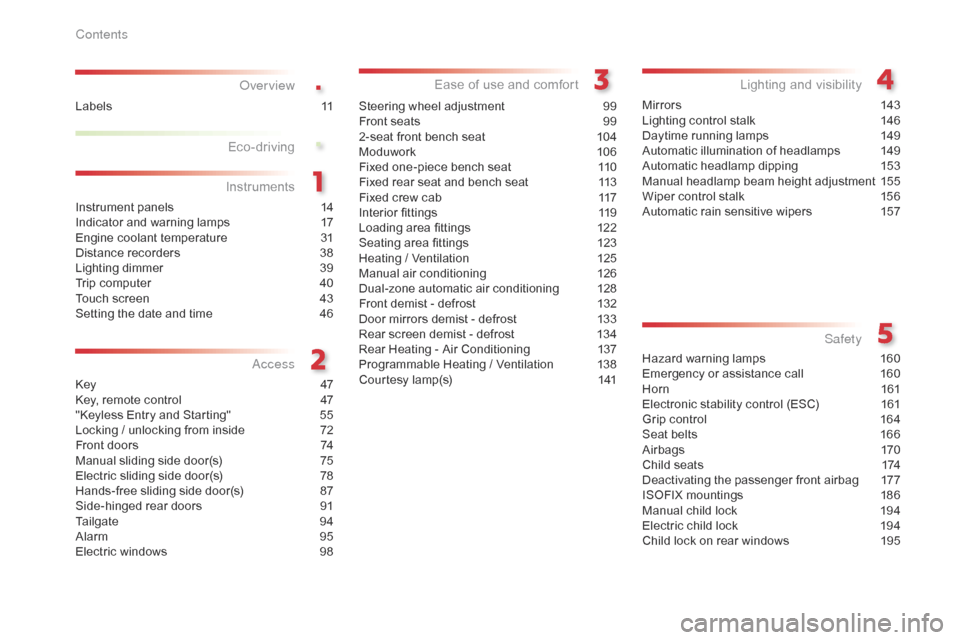
.
.
Over view
Instrument panels 14
Indicator and warning lamps 1 7
Engine coolant temperature
3
1
Distance recorders
3
8
Lighting dimmer
3
9
Trip computer
4
0
Touch screen
4
3
Setting the date and time
4
6
Key
47
K
ey, remote control
4
7
"Keyless Entry and Starting"
5
5
Locking / unlocking from inside
7
2
Front doors
7
4
Manual sliding side door(s)
7
5
Electric sliding side door(s)
7
8
Hands-free sliding side door(s)
87
S
ide-hinged rear doors
9
1
Tailgate
9
4
Alarm
9
5
Electric windows
9
8Steering wheel adjustment
9
9
Front seats
9
9
2-seat front bench seat
1
04
Moduwork
1
06
Fixed one-piece bench seat
1
10
Fixed rear seat and bench seat
1
13
Fixed crew cab 1 17
Interior fittings 1 19
Loading area fittings
1
22
Seating area fittings
1
23
Heating / Ventilation
1
25
Manual air conditioning
1
26
Dual-zone automatic air conditioning
1
28
Front demist - defrost
1
32
Door mirrors demist - defrost
1
33
Rear screen demist - defrost
1
34
Rear Heating - Air Conditioning
1
37
Programmable Heating / Ventilation
1
38
Courtesy lamp(s)
1
41Mir ror s
14
3
Lighting control stalk
1
46
Daytime running lamps
1
49
Automatic illumination of headlamps
1
49
Automatic headlamp dipping
1
53
Manual headlamp beam height adjustment
1
55
Wiper control stalk 1 56
Automatic rain sensitive wipers 1 57
Hazard warning lamps
1
60
Emergency or assistance call
1
60
Horn
16
1
Electronic stability control (ESC)
1
61
Grip control
1
64
Seat belts
1
66
Airbags
1
70
Child seats
1
74
Deactivating the passenger front airbag
1
77
ISOFIX mountings
1
86
Manual child lock
1
94
Electric child lock
1
94
Child lock on rear windows
1
95
Eco-driving
Instruments
Access Ease of use and comfort
Lighting and visibility
Safety
Labels 1 1
Contents
Page 9 of 520
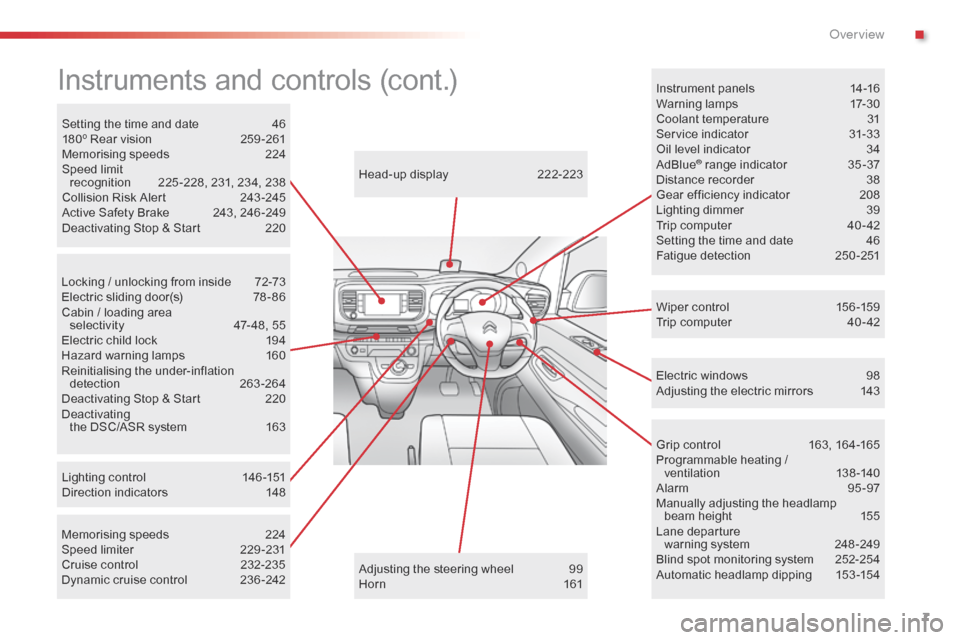
7
Locking / unlocking from inside 72-73
Electric sliding door(s) 7 8 - 86
Cabin / loading area selectivity
4
7- 48, 55
Electric child lock
1
94
Hazard warning lamps
1
60
Reinitialising the under-inflation detection
26
3-264
Deactivating Stop & Start
2
20
Deactivating
the DSC/ASR system
1
63Adjusting the steering wheel
9
9
Horn
16
1
Head-up display
2
22-223
Instruments and controls (cont.)
Wiper control 1
56 -159
Trip computer 4 0 - 42
Memorising speeds
2
24
Speed limiter
2
29-231
Cruise control
2
32-235
Dynamic cruise control
2
36 -242 Instrument panels
1
4-16
Warning lamps
1
7-30
Coolant temperature
3
1
Service indicator
3
1-33
Oil level indicator
3
4
AdBlue
® range indicator 3 5 -37
Distance recorder 3 8
Gear efficiency indicator
2
08
Lighting dimmer
3
9
Trip computer
4
0 - 42
Setting the time and date
4
6
Fatigue detection
2
50-251
Electric windows
9
8
Adjusting the electric mirrors
1
43
Grip control
1
63, 164-165
Programmable heating / ventilation
1
38-140
Alarm
9
5-97
Manually adjusting the headlamp
beam height
1
55
Lane departure
warning system
24
8 -249
Blind spot monitoring system
2
52-254
Automatic headlamp dipping
1
53 -154
Setting the time and date
4
6
180º Rear vision
2
59 -261
Memorising speeds
2
24
Speed limit recognition
2
25 -228, 231, 234, 238
Collision Risk Alert
2
43 -245
Active Safety Brake
2
43, 246 -249
Deactivating Stop & Start
2
20
Lighting control
1
46 -151
Direction indicators
1
48
.
Over view
Page 12 of 520
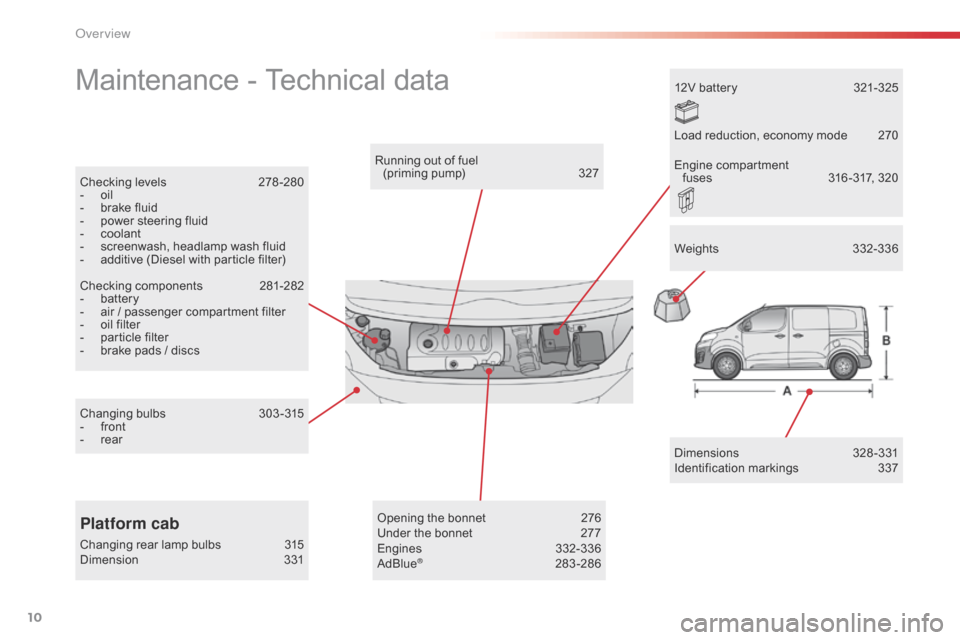
10
Maintenance - Technical data
Dimensions 328-331
Identification markings 3 37
Running out of fuel
(priming pump)
3
27
Checking levels
2
78 -280
-
o
il
-
b
rake fluid
-
p
ower steering fluid
-
c
oolant
-
s
creenwash, headlamp wash fluid
-
a
dditive (Diesel with particle filter)
Checking components
2
81-282
-
b
attery
-
a
ir / passenger compartment filter
-
o
il filter
-
p
article filter
-
b
rake pads / discs
Changing bulbs
3
03-315
-
f
ront
-
r
ear
Platform cab
Changing rear lamp bulbs 3
15
Dimension 3 31 12V battery
3
21-325
Opening the bonnet
2
76
Under the bonnet 2 77
Engines 3 32-336
AdBlue® 28 3-286Weights
33
2-336
Load reduction, economy mode
2
70
Engine compartment
fuses
3
16 -317, 320
Over view
Page 20 of 520

18
Warning / indicator lampStateCause Action / Observations
STOP fixed, associated with
another warning lamp,
accompanied by an
audible signal and a
message. Illumination of this warning lamp is
related to a serious fault detected
with the engine, the braking system,
the power steering, etc., or a major
electrical fault. You must stop as soon as it is safe to do so.
Park, switch off the ignition and call a CITROËN
dealer or a qualified workshop.
Parking brake fixed. The parking brake is applied or not
properly released. Release the parking brake to switch off the warning
lamp, keeping your foot on the brake pedal.
Observe the safety recommendations.
For more information on the Parking brake
, refer to
the corresponding section.
Braking fixed. The brake fluid level has dropped
significantly. You must stop as soon as it is safe to do so.
Top-up with brake fluid listed by CITROËN.
If the problem persists, have the system checked by a
CITROËN dealer or a qualified workshop.
+ fixed, associated
with the ABS warning
lamp.The electronic brake force distribution
(EBFD) system has a fault.
You must stop as soon as it is safe to do so.
Have it checked by a CITROËN dealer or a qualified
workshop.
Instruments
Page 27 of 520

25
Warning / indicator lampStateCause Action / Observations
Power steering fixed. The power steering has a fault. Drive carefully at reduced speed.
Have it checked by a CITROËN dealer or a qualified
workshop.
Dynamic
stability control
(DSC/ASR)
flashing.
The DSC/ASR regulation is
operating. The system optimises traction and improves the
directional stability of the vehicle in the event of loss of
grip or trajectory.
fixed. The DSC/ASR system has a fault. Have the system checked by a CITROËN dealer or a
qualified workshop.
Dynamic
stability control
(DSC/ASR)
fixed.
The button is pressed and the
indicator lamp comes on.
The DSC/ASR is deactivated.
DSC: dynamic stability control.
ASR: anti-slip regulation. Press the button to activate the DSC/ASR. Its
indicator lamp goes off.
The DSC/ASR system is activated automatically when
the vehicle is started.
If deactivated, the system is reactivated automatically
from around 30 mph (50 km/h).
For more information on the Electronic stability
programme (ESC)
and in particular, DSC/ASR, refer
to the corresponding section.
1
Instruments
Page 42 of 520

40
System that gives you information on the current journey (range, fuel consumption…).
Trip computer
Display of information
F Press the button on the end of the wiper control stalk to display the different trip
computer tabs in turn. F
O
r, depending on equipment, press the
thumbwheel on the steering wheel .-
T
he current information with:
●
t
he range,
●
t
he current fuel consumption,
●
t
he Stop & Start time counter.
Tr i p s "1" and "2" are independent but their use
is identical.
For example, trip "1" can be used for daily
figures, and trip "2" for monthly figures.
-
T
rip "2"
with:
●
t
he average speed,
●
t
he average fuel consumption,
●
t
he distance travelled,
f
or the second trip.
-
T
rip "1"
with:
●
t
he average speed,
●
t
he average fuel consumption,
●
t
he distance travelled,
f
or the first trip.
Depending on equipment, a 2
nd trip is available.
Instruments
Page 43 of 520

41
Trip reset
With LCD text instrument panel
F When the trip is displayed, press the button on the end of the wiper control stalk .
F
O
r, depending on equipment, press the
thumbwheel on the steering wheel for
more than two seconds.
F
W
hen the desired trip is displayed, press
the reset button in the instrument panel for
more than two seconds.
With LCD text or matrix
instrument panel
With LCD instrument panel
F When the trip is displayed, press the button on the end of the wiper control stalk for
two seconds.
1
Instruments
Page 73 of 520

71
Lost keys, remote control
Visit a CITROËN dealer with the vehicle's
registration certificate, your personal
identification documents and if possible, the
label bearing the key code.
The CITROËN dealer will be able to retrieve
the key code and the transponder code
required to order a new key.
Locking the vehicle
Driving with the doors locked may make
access to the passenger compartment by
the emergency services more difficult in an
emergency.
As a safety precaution (with children on
board), remove the key from the ignition
or take the remote control with you when
leaving the vehicle, even for a short time.
When purchasing a second-
hand vehicle
Have the key codes memorised by a
CITROËN dealer, to ensure that the keys in
your possession are the only ones which can
start the vehicle.
Electrical interference
The Keyless Entry and Starting remote
control may not operate if close to certain
electronic devices: telephone, laptop
computer, strong magnetic fields, ...Accumulations (water, dust, grime,
salt...) on the inner sur face of the door
handle may affect detection.
If cleaning the inner sur face of the door
handle using a cloth does not restore
detection, contact a CITROËN dealer or
a qualified workshop.
A sudden splash of water (stream of
water, high pressure jet washer, …) may
be identified by the system as the desire
to open the vehicle.
Remote control
The high frequency remote control is a
sensitive system; do not operate it while it is
in your pocket as there is a possibility that
it may unlock the vehicle, without you being
aware of it.
Do not repeatedly press the buttons of your
remote control out of range and out of sight
of your vehicle. You run the risk of stopping
it from working and the remote control would
have to be reinitialised.
The remote control does not operate when
the key is in the ignition, even when the
ignition is switched off.
Anti-theft protection
Do not make any modifications to the
electronic engine immobiliser system; this
could cause malfunctions.
Do not forget to turn the steering to engage
the steering lock.
2
Access
Page 101 of 520
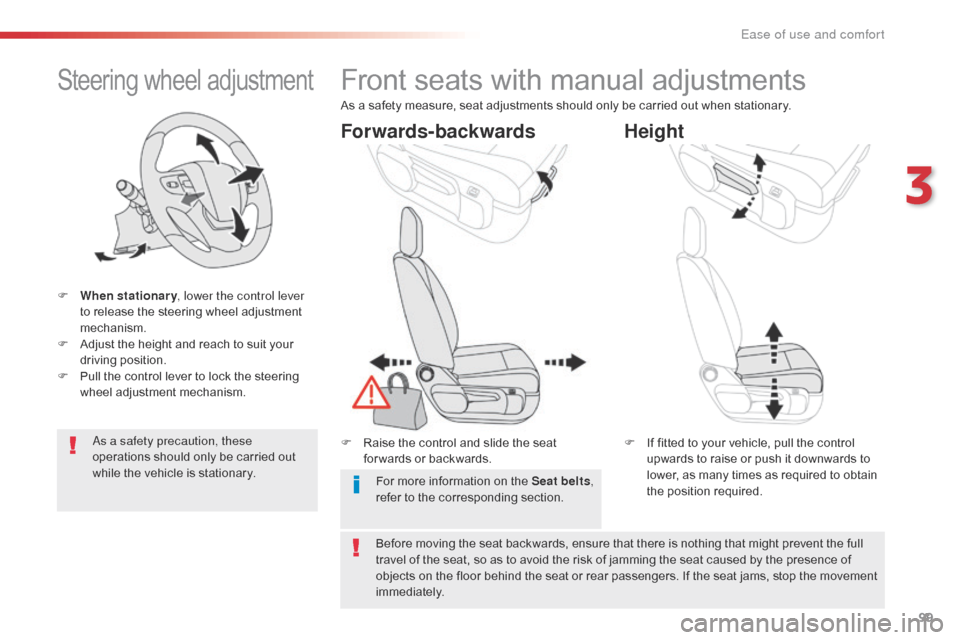
99
Steering wheel adjustment
F When stationary, lower the control lever
to release the steering wheel adjustment
mechanism.
F
A
djust the height and reach to suit your
driving position.
F
P
ull the control lever to lock the steering
wheel adjustment mechanism.
As a safety precaution, these
operations should only be carried out
while the vehicle is stationary.
Front seats with manual adjustments
F Raise the control and slide the seat for wards or backwards. F
I f fitted to your vehicle, pull the control
upwards to raise or push it downwards to
lower, as many times as required to obtain
the position required.
Forwards-backwards Height
As a safety measure, seat adjustments should only be carried out when stationary.
Before moving the seat backwards, ensure that there is nothing that might prevent the full
travel of the seat, so as to avoid the risk of jamming the seat caused by the presence of
objects on the floor behind the seat or rear passengers. If the seat jams, stop the movement
immediately. For more information on the Seat belts ,
refer to the corresponding section.
3
Ease of use and comfort
Page 123 of 520
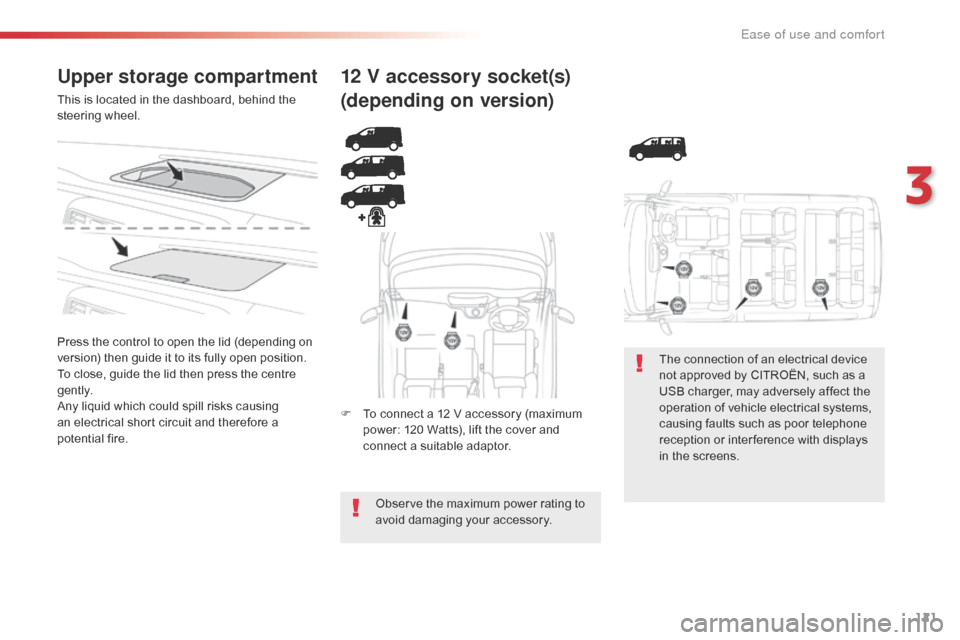
121
Upper storage compartment
This is located in the dashboard, behind the
steering wheel.
Press the control to open the lid (depending on
version) then guide it to its fully open position.
To close, guide the lid then press the centre
g e nt l y.
Any liquid which could spill risks causing
an electrical short circuit and therefore a
potential fire.
12 V accessory socket(s)
(depending on version)
F To connect a 12 V accessory (maximum power: 120 Watts), lift the cover and
connect a suitable adaptor.
Observe the maximum power rating to
avoid damaging your accessory. The connection of an electrical device
not approved by CITROËN, such as a
USB charger, may adversely affect the
operation of vehicle electrical systems,
causing faults such as poor telephone
reception or inter ference with displays
in the screens.
3
Ease of use and comfort